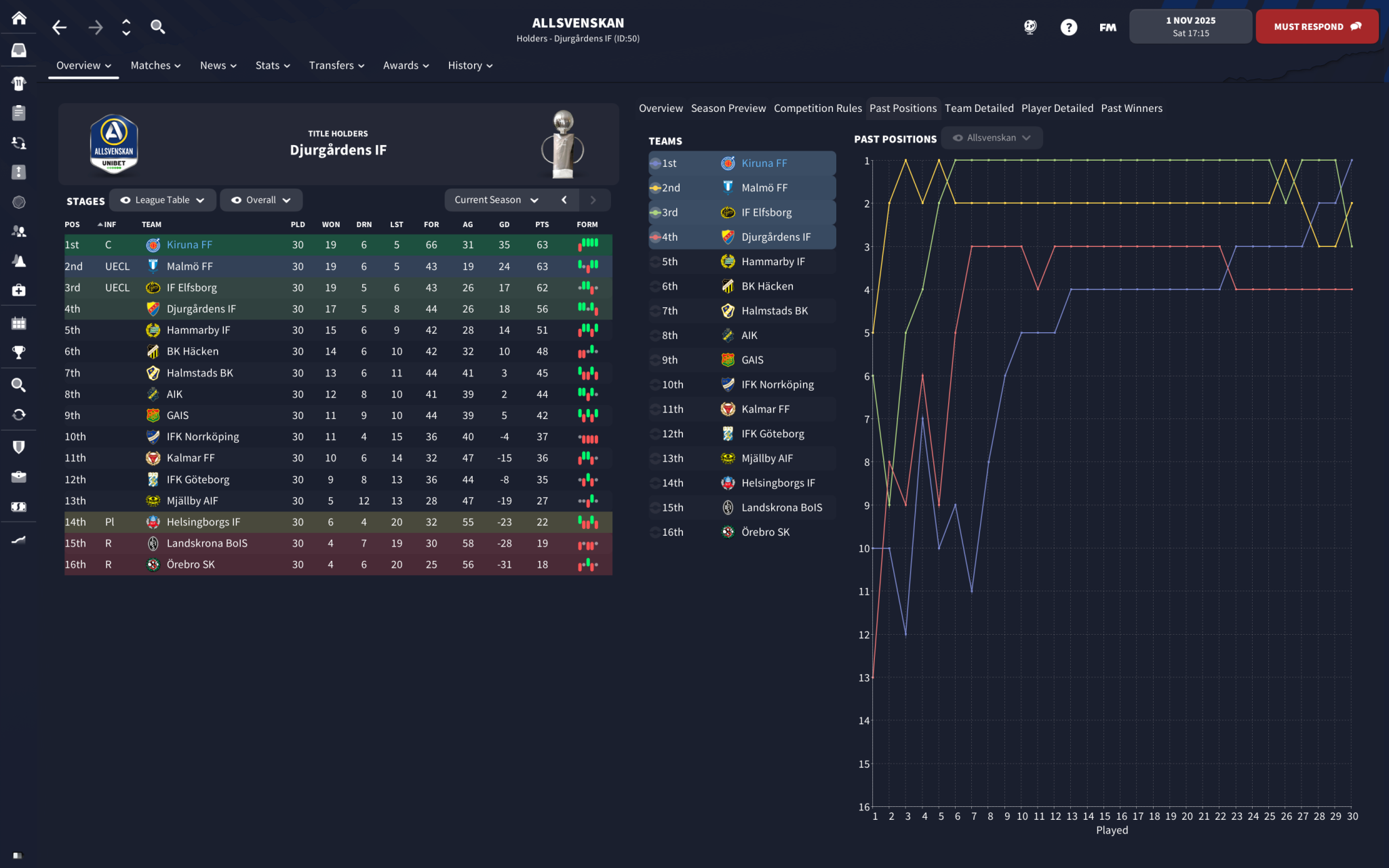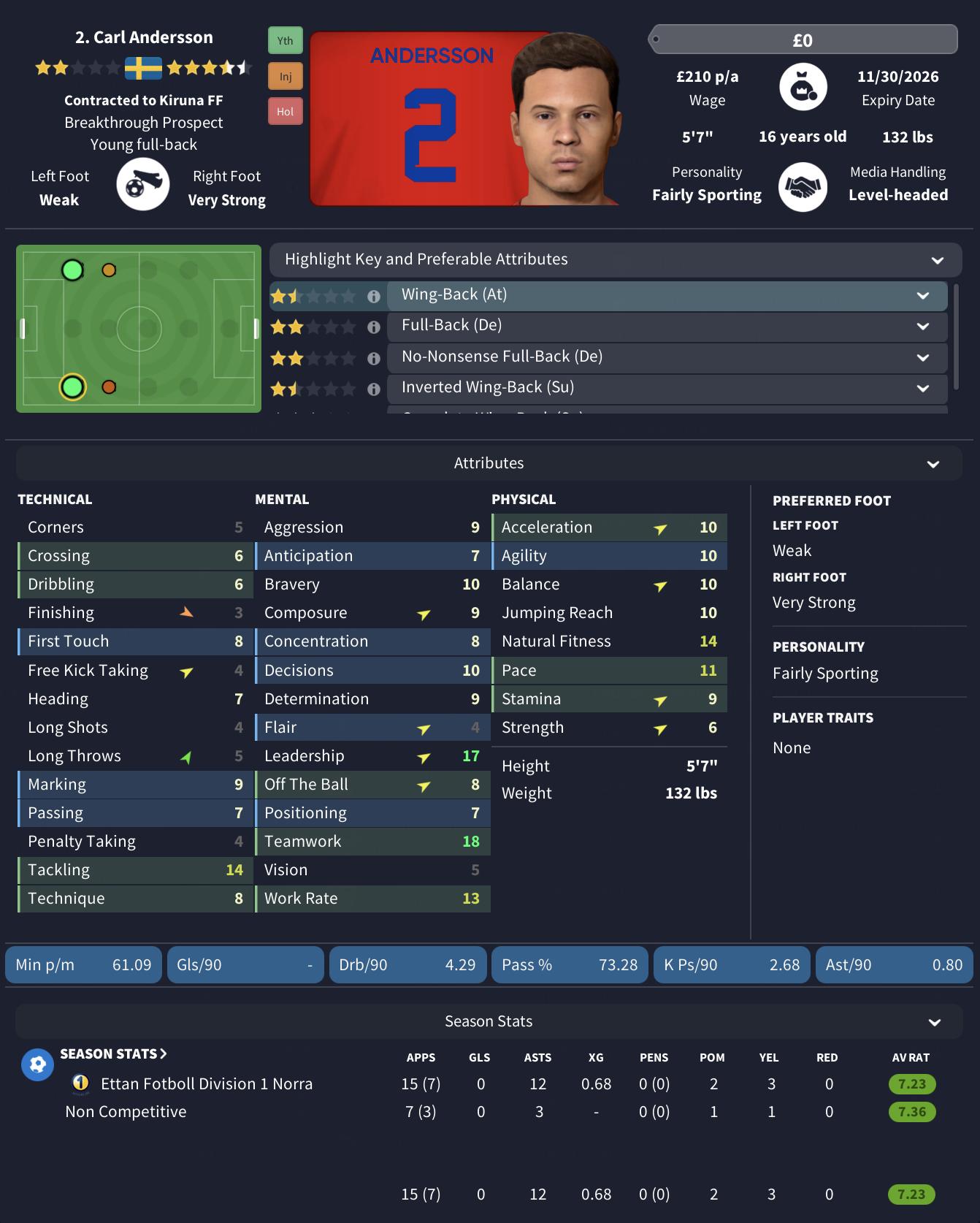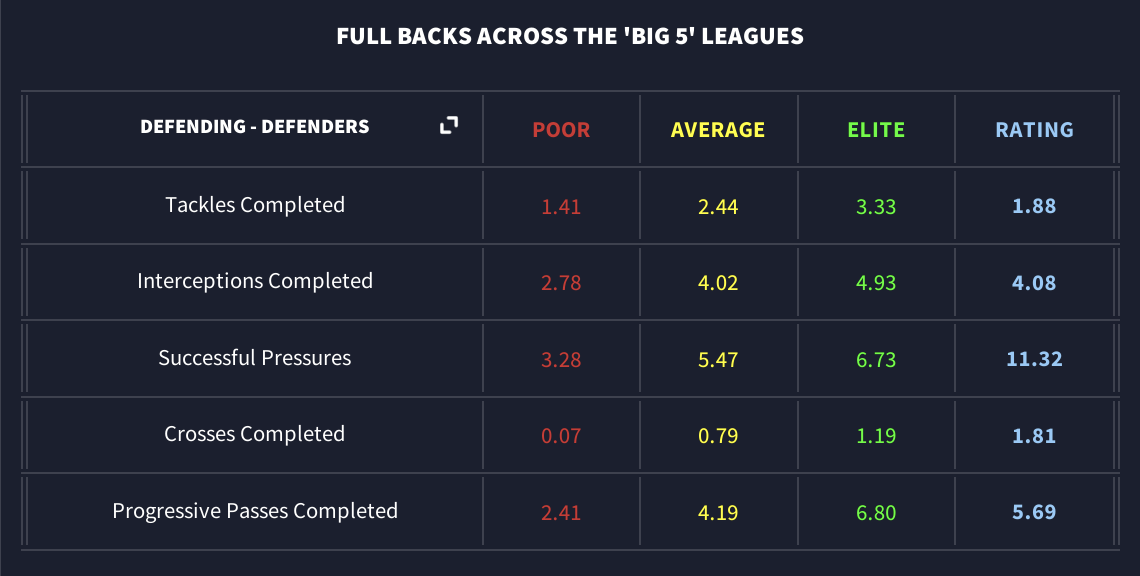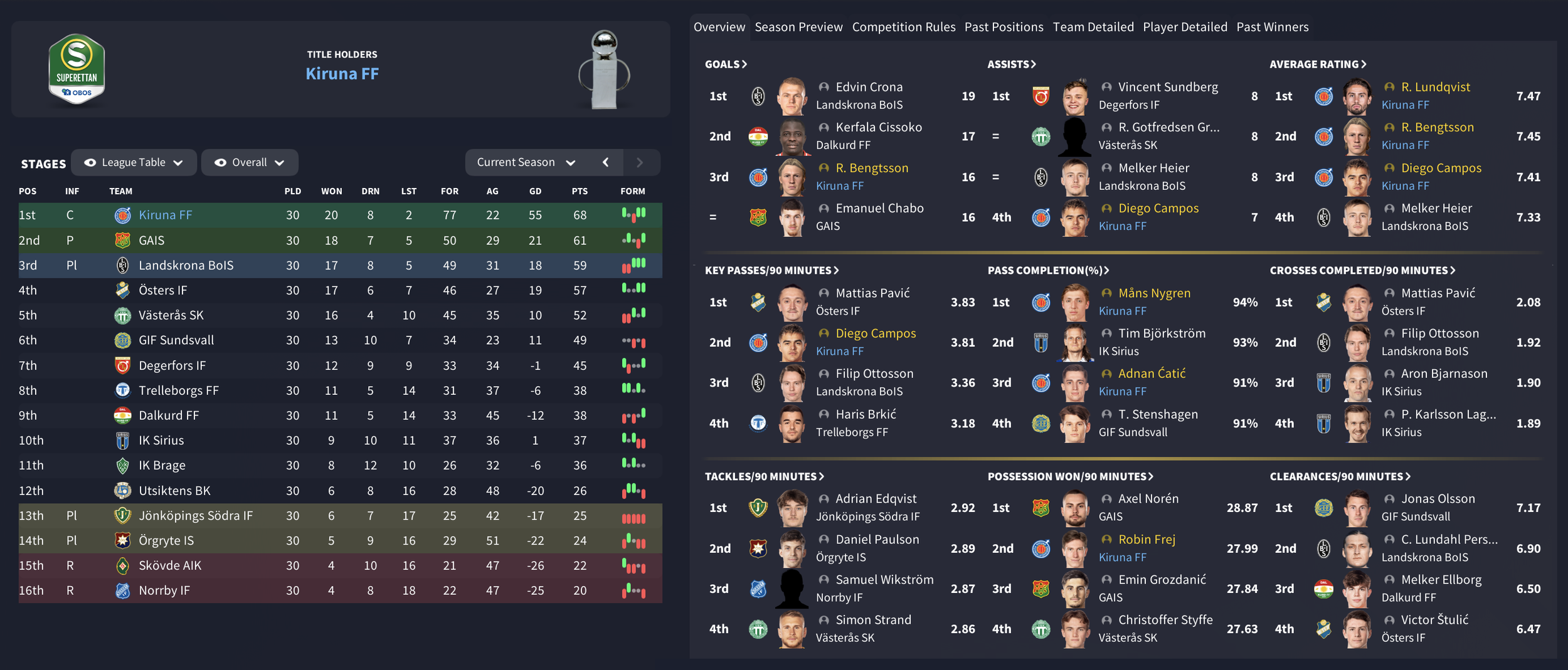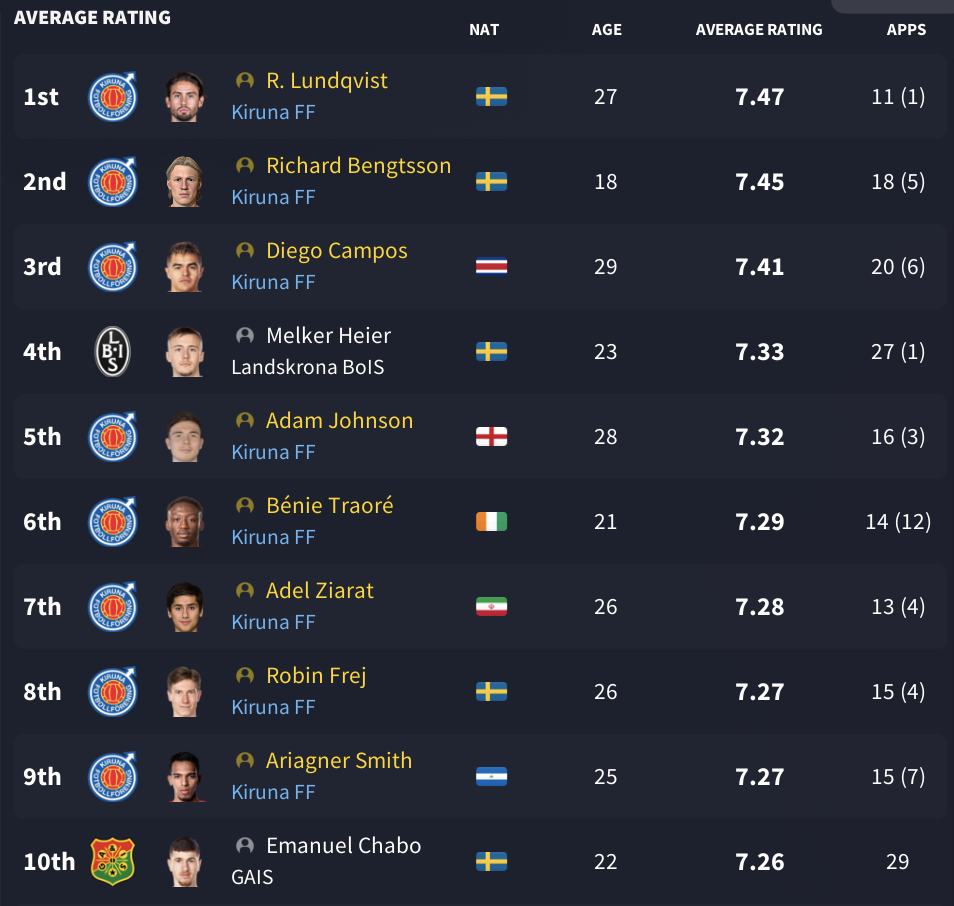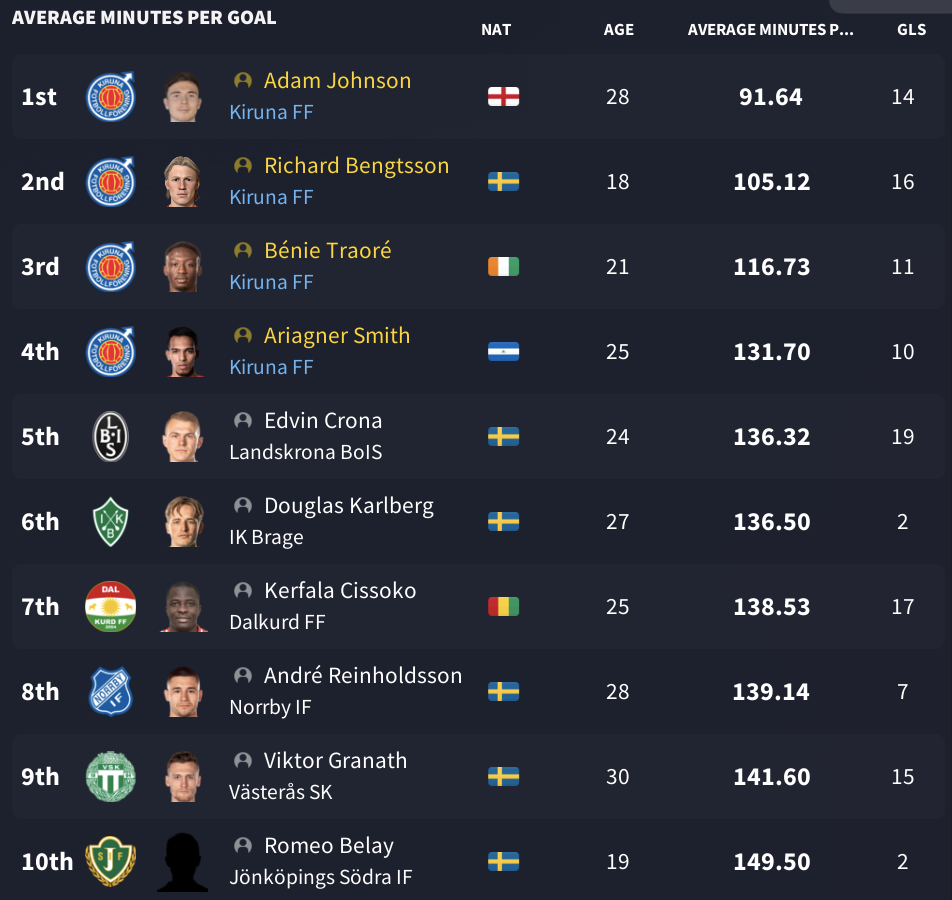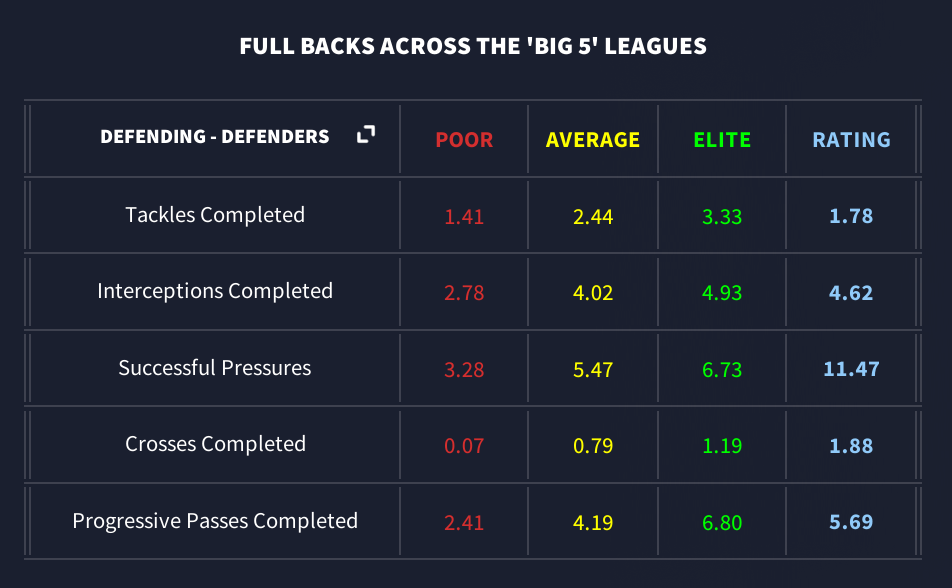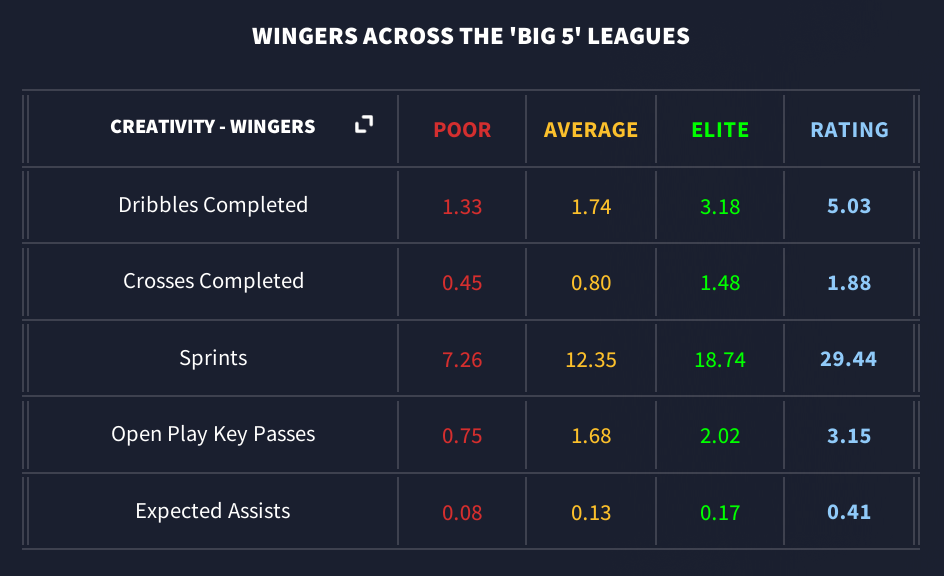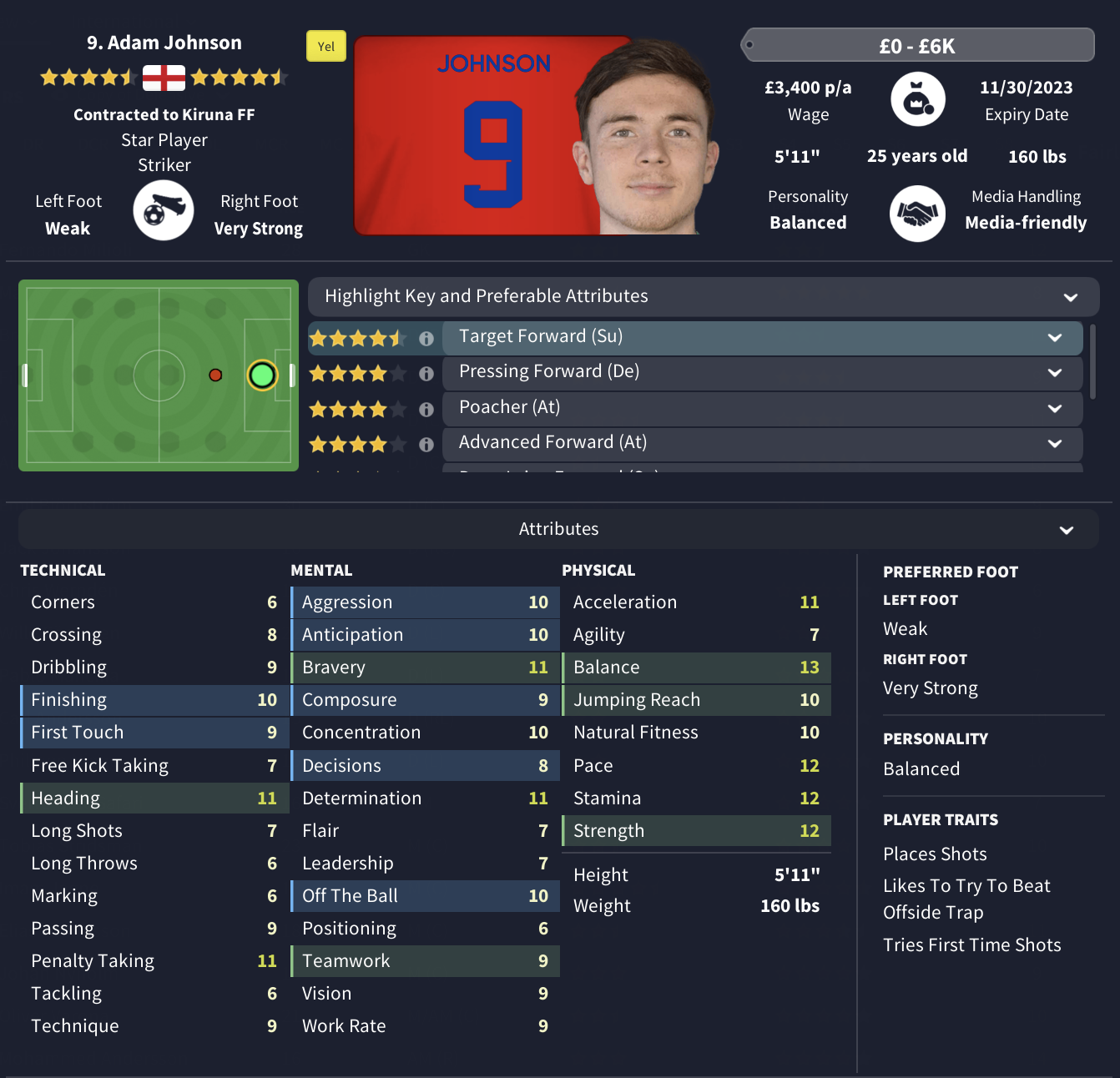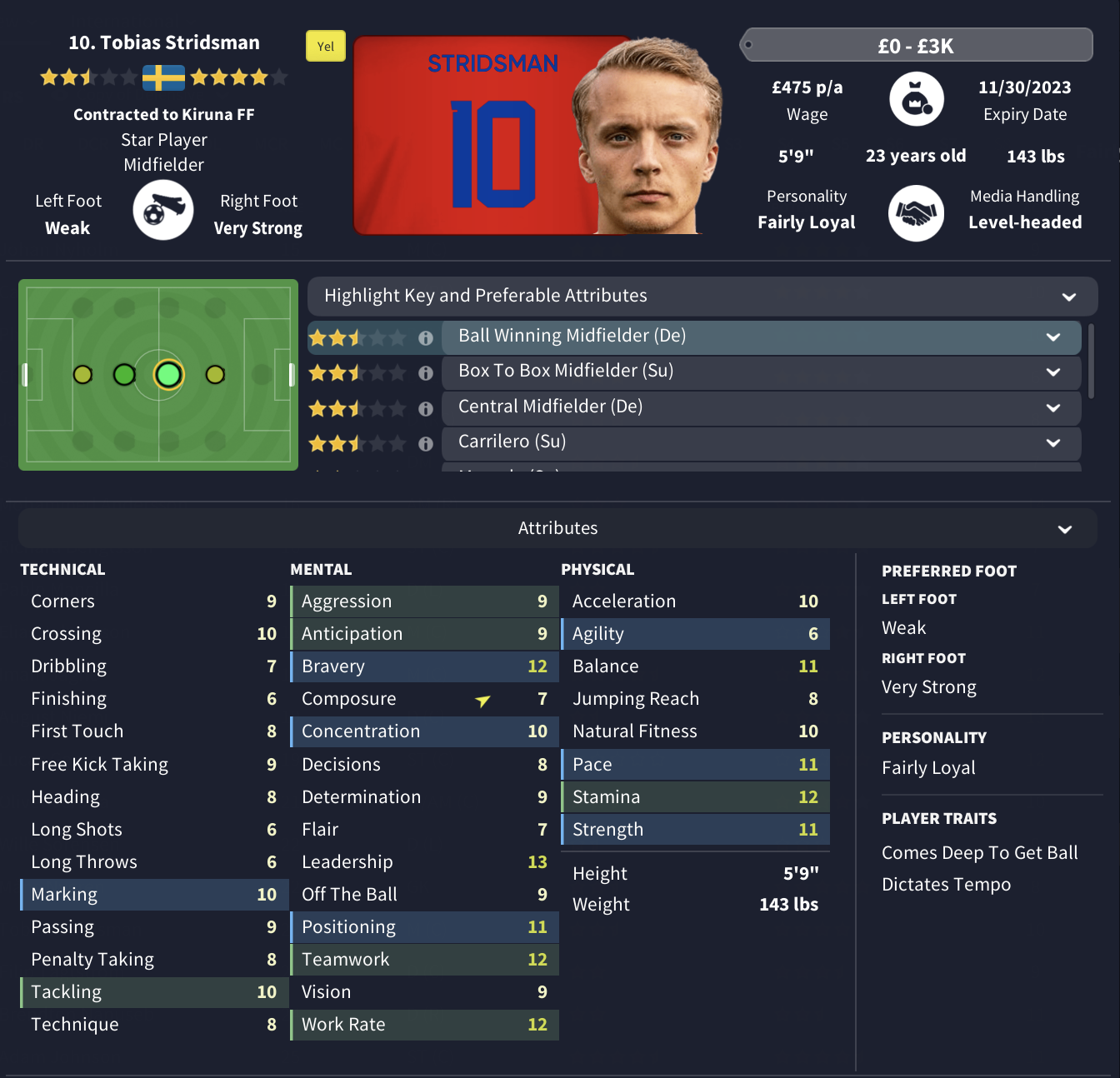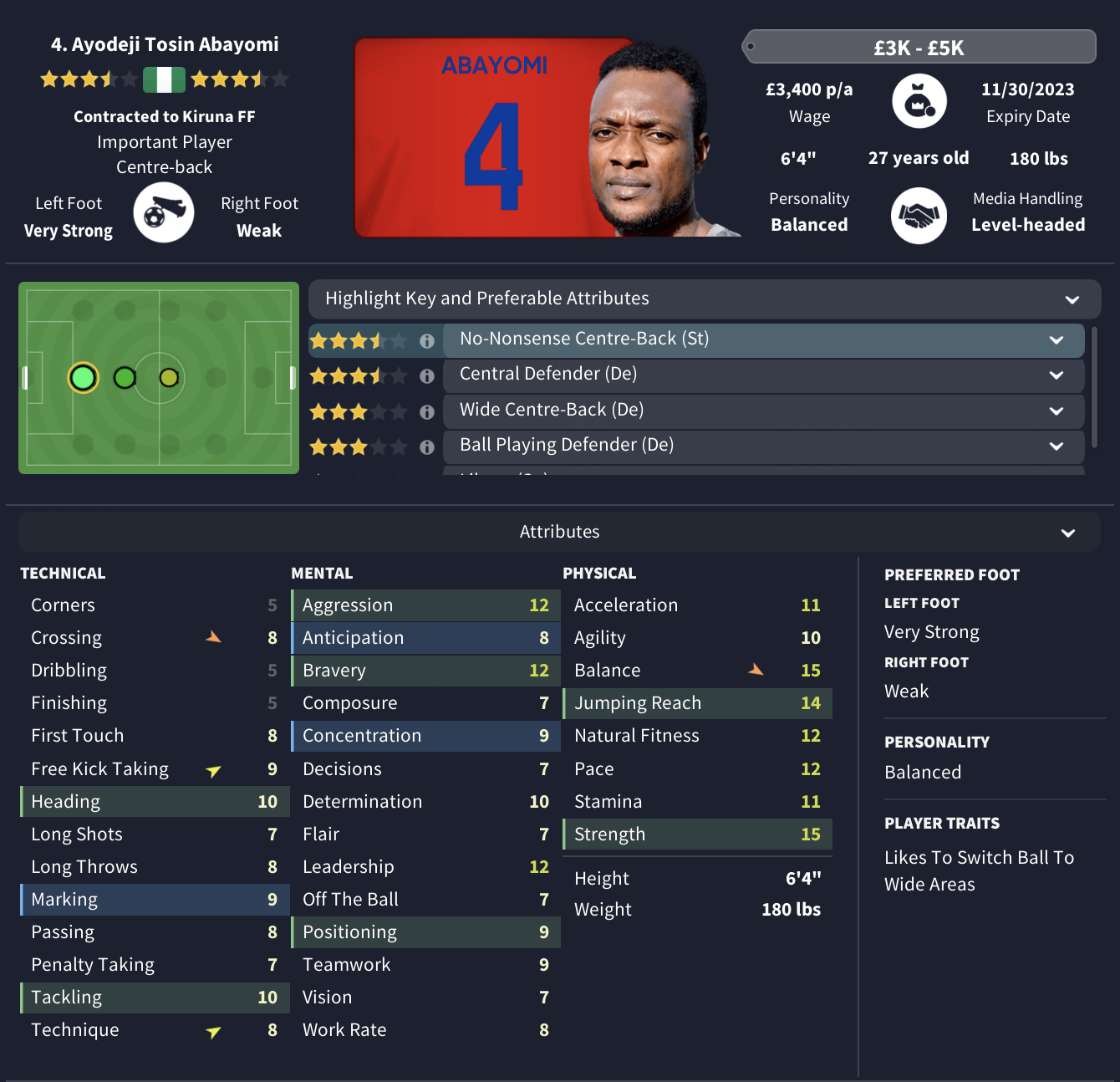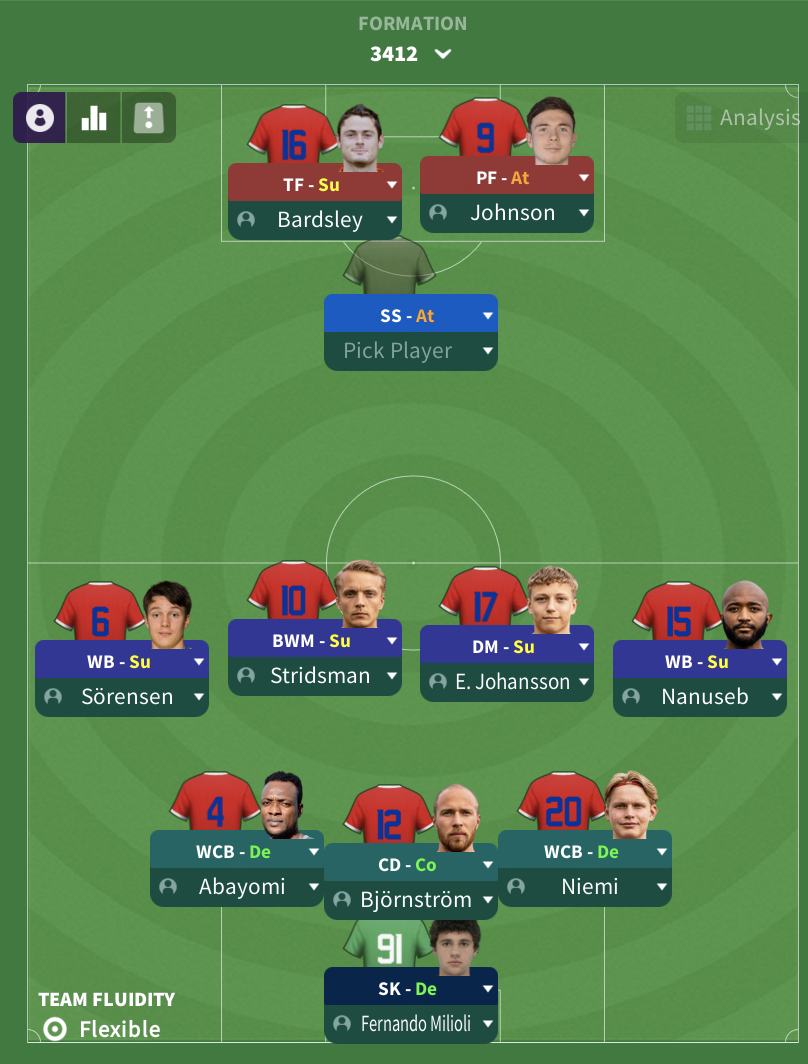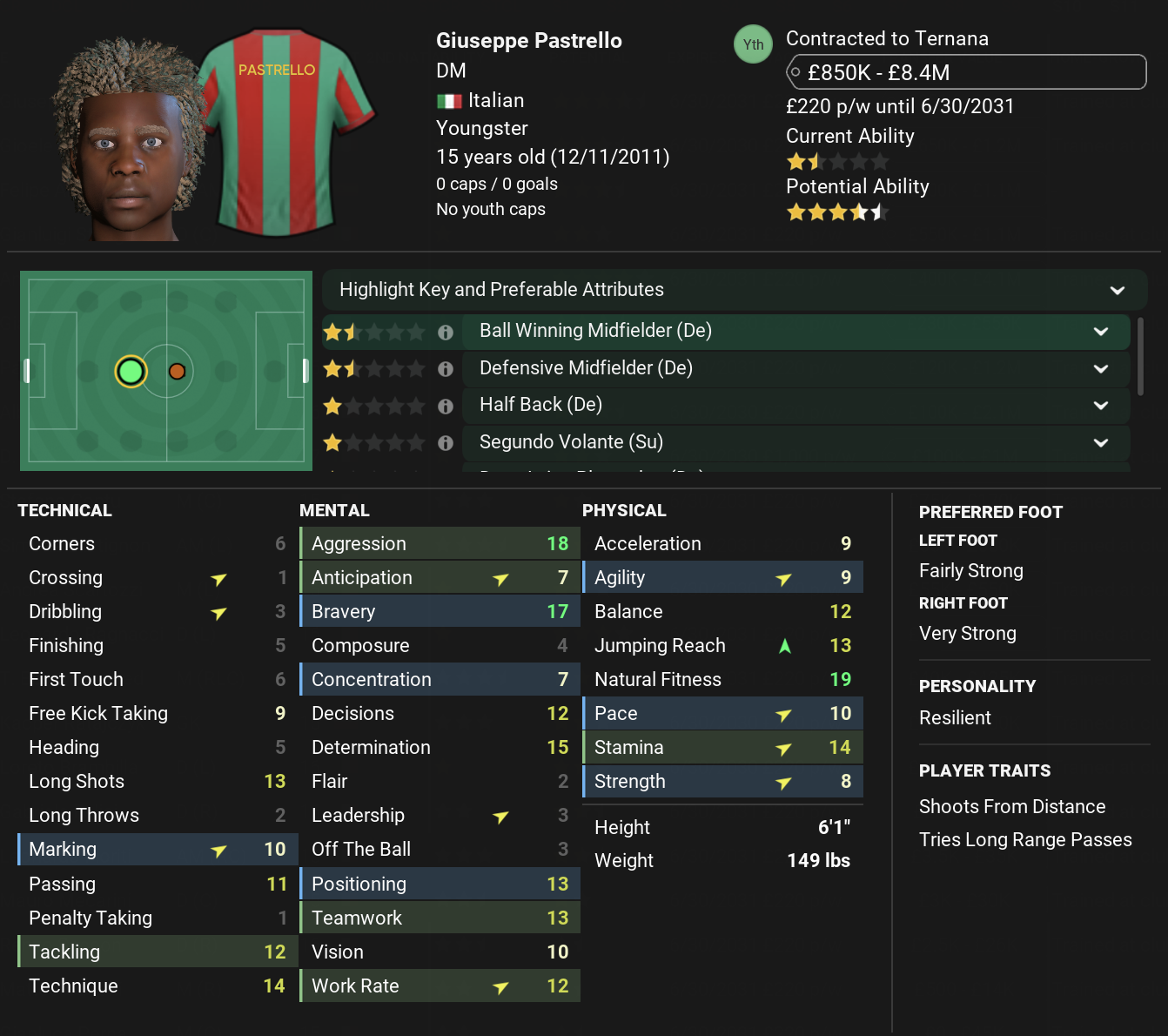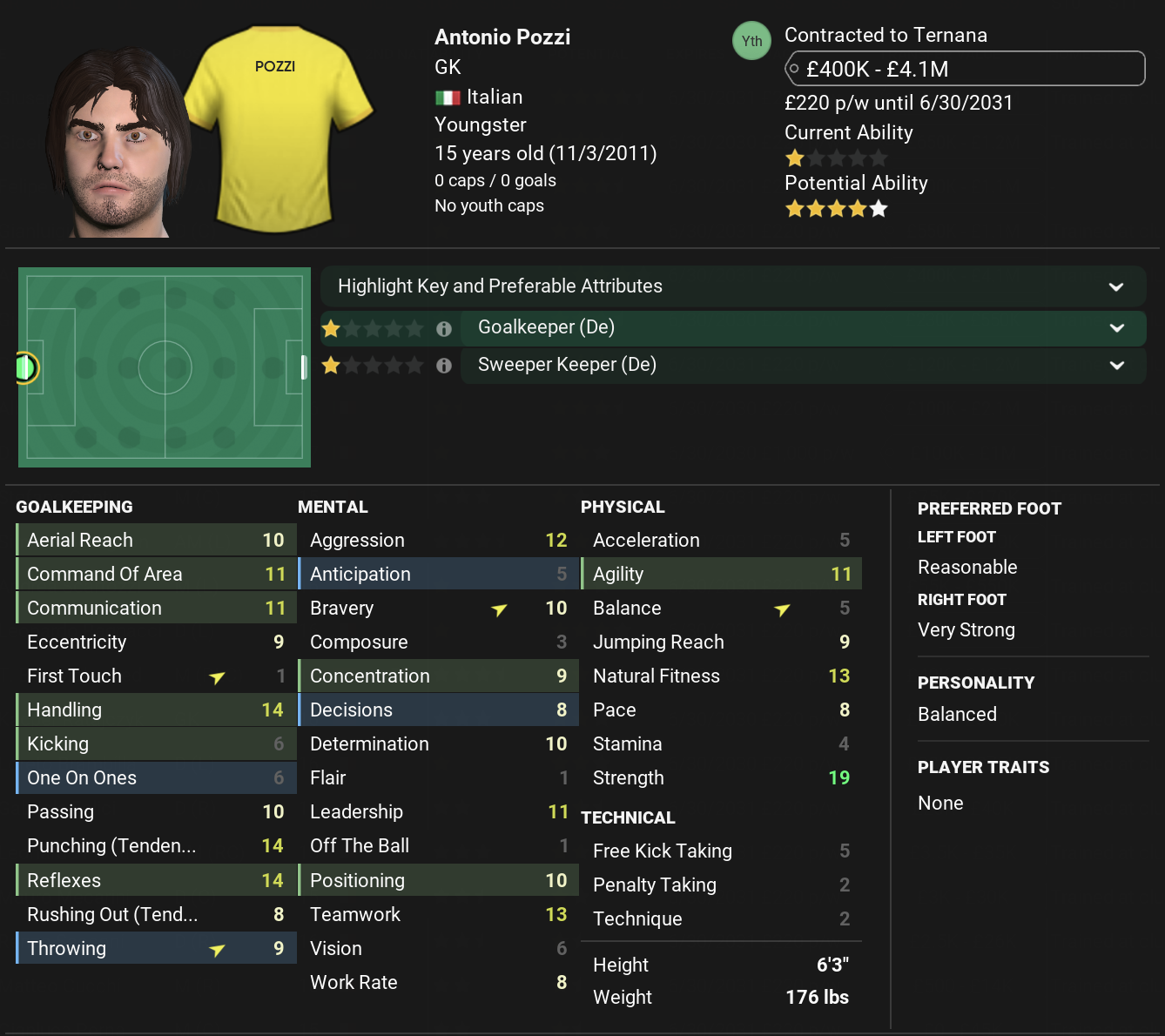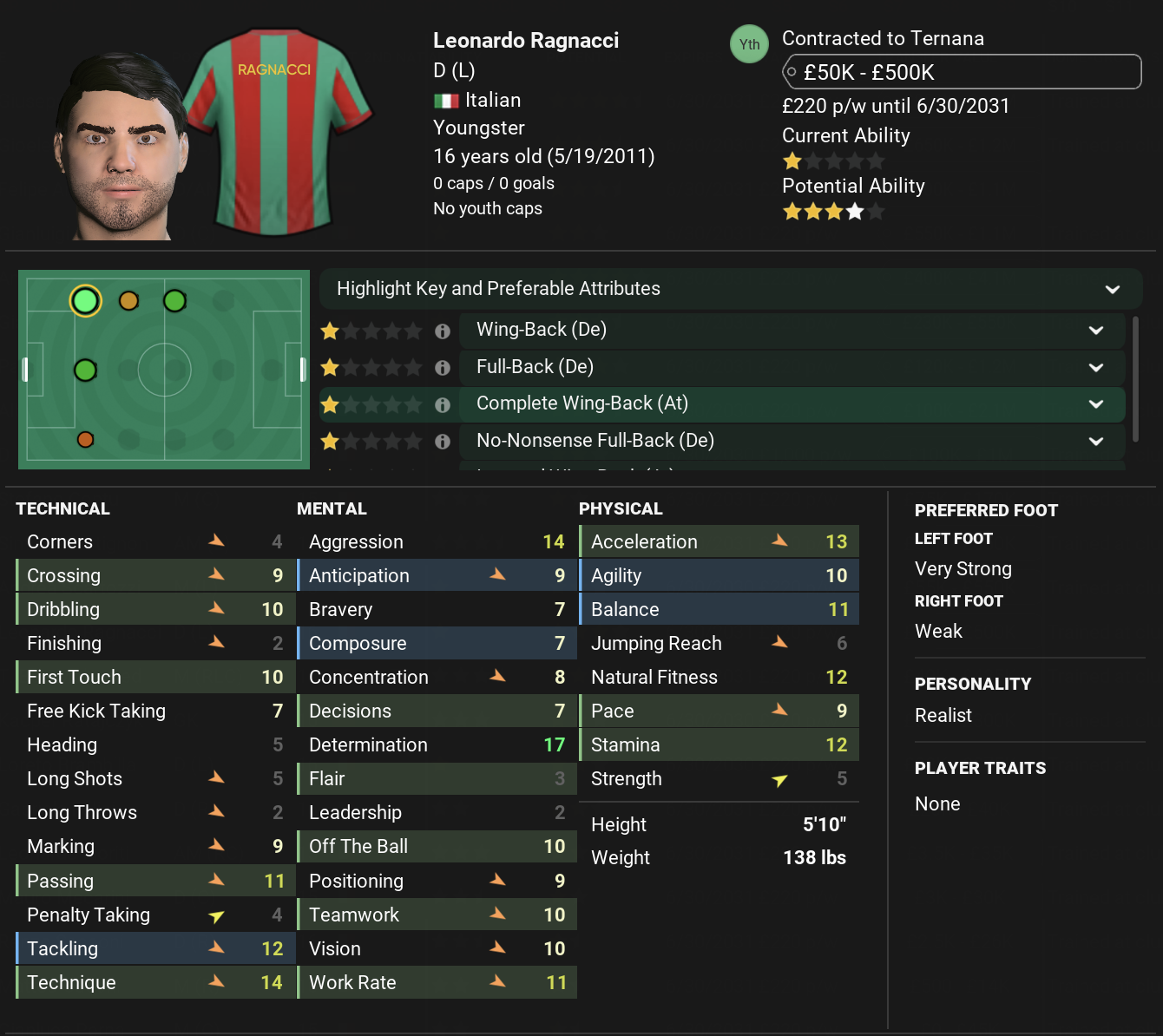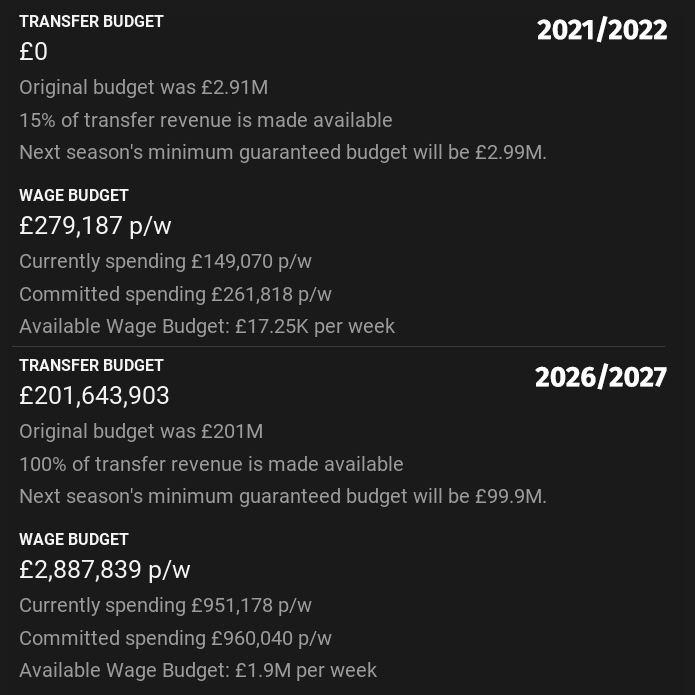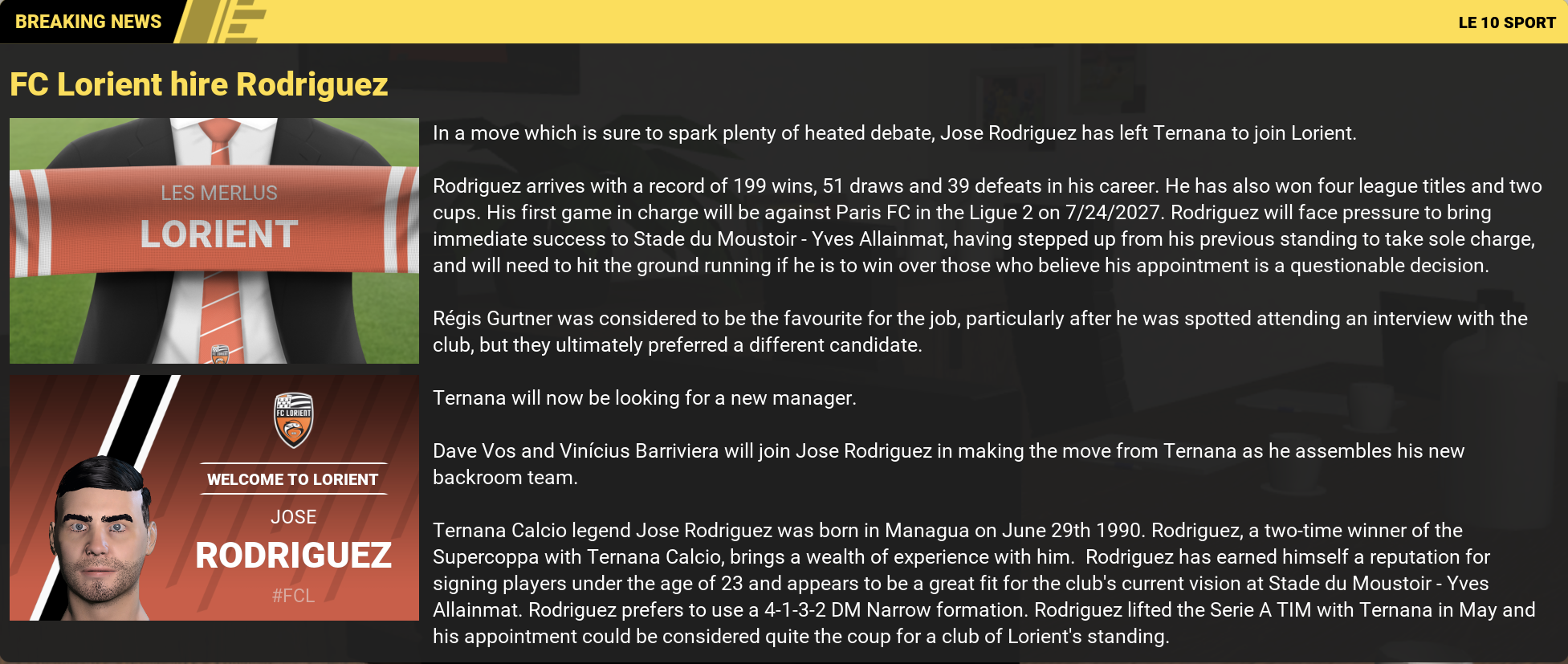Hello again!
Originally this post was meant to be a deep dive into the finances at the club during my first three seasons. Instead, I played another season. It’s been a ton of fun, and It’s hard to stop when you’re on a hot streak. But I want to make A FM Old Timer proud one day with a proper finance post.
Let’s take a look at my first season in the Allsvenskan.
Transfers
Promotion can be a bitch. On the one hand, it guarantees some prize money and TV exposure, which can benefit the rest of the club. On the other hand, it also puts the team in the spotlight, drawing attention from other teams, not just in Sweden but across Europe. Unfortunately, our short summer transfer window was a disadvantage compared to other European clubs that were enjoying their longer transfer period.
We sold 23 players for a total of £5.3M, with twelve going to Allsvenskan sides and the remaining ten heading to teams in Denmark, France, Germany, and Norway. The loss of our three best central defenders, Adel Ziarat (£5K, AIK), Adnan Ćatić (£50K, Helsingborgs IF), and Robin Frej (£16.5K, IFK Götenborg), was tough to swallow. We also had to say goodbye to some fan favorites, including Willie Sörensen (£6.5K, GAIS), Oliver Verona (£240K, Sion), Måns Nygren (£60K, Sandefjord), and legend Adam Johnson (£8.25K, GIF Sundsvall).
To fill the gaps in the first team, we brought in some promising new players, such as goalkeeper Sebastian Selin (free, Hammarby IF), Yannick Adjoumani (free, BK Häcken), Mayer Gil (free, Águilas Doradas), Poul Kallsberg (free, Djurgårdens IF), Oscar Aga (£78K, IF Elfsborg), August Sandström (£3.6K, Lunds BK), Matias Belli Moldskred (free, Sandnes Ulf), and Marcus Ferkranus (free, LA Galaxy). We also signed six Central American youngsters and several young Swedish players. We spent a total of £90K for 21 players, most of whom would play in the reserve and U19 teams.
First Team
During the season, our first team consisted of 26 players. Still, towards the end of the season, we played a league-high 37 players, focusing on plenty of rotation to give opportunities to some reserve and U19 players.
Four new signings snuck into our starting eleven. Sebastian Selin took over as our no.1 following Nygren’s departure. John Clarke and Marcus Ferkranus filled the gap left by our departing central defenders, and Diego Campos secured the starting spot at right wingback. Omar Alba also joined towards the end of the season and will begin the next as our left wingback, while Chris Andersson and Philippe Niang will rotate at right and left wingback.
Youth Intake’s favorite, Joe Hodge, will begin as our BWM(D)/CM(D), with Matias Belli Moldskred as our CM(S) and Ramon-Pascal Lundqvist as our CM(A). Club legend Tobias Stridsman, Johan Nyholm, and Nicaraguan international Jacob Montes will support this midfield trio.
Our team’s attack will be led by Benié Traoré as our shadow striker, with support from Enrico Dueñas and Adam Bark. August Sandström and Poul Kallsberg will play wherever needed due to their versatility. Our striker duo will comprise new club captain Robert Bengtsson and Oscar Aga. Their backups will be Kiruna’s wonderkid, Mirsad Ziba, and South Korean youth international Sang-Jun Park.
Svenska Cupen
We played in the Svenska Cupen for the first time, having qualified for the group stage and placed in a favorable group. We secured our position at the top of the group after defeating IF Bromma (4-0), Västerås SK (3-0), and IK Norrköping (7-0). Moving onto the quarter-finals, we faced Halmstads BK, winning with a hat-trick from legend Adam Johnson, securing a 3-2 win. However, our cup journey ended in the semi-finals as we faced Malmo FF. Despite a brave effort from our team, Malmo FF dominated possession with 60% compared to our 40% and had more chances on goal, taking 21 shots compared to our 6. Nigel Robertha scored the winning goal to end the match (1-0).
Allsvenskan
Our first team in Sweden’s first tier was a fun one. The team took a while to hit their stride as we began the season with three straight draws, IFK Göteborg (1-1), BK Häcken (2-2), and Landskrona BoIS (1-1). Even though we dominated all matches in possession and shots, averaging over 20+ shots and 60%, we were only able hit the target six times in each of the matches. We turned things around in the next three matches, winning two against AIK (2-0) and Örebrok SK (1-0)and losing one against IF Elsborg (2-4).
Performances continued to improve in the next nine matches, winning five against the likes of GAIS (2-0), Helsingborgs IF (4-2), and Kalmar FF (2-0). We also lost three more matches against Hammarby IF (0-1), Mjällby AIF (2-4), and Djurgärdens IF (2-3). A 56-minute goal from Richard Bengtsson helped us draw (1-1) against Malmö FF. Halfway through the season, we found ourselves in 4th place.
Although we were slowly climbing up the table, we struggled to put the ball in the back of the net. We led the league in all attacking metrics (goals, crosses completed, chances created, etc.) but still underperforming our xG by -6.75, our 34% shots on target were 14th in the league, and we were tied dead last at a 9% conversion rate. Yes, that conversion rate is horrible, but the highest rate in the league was 15%, so it wasn’t just us that could not score or hit the target.
The team improved in the second half of the season, going on a ten-match unbeaten run. Those changes to our approach paid off in a big way. We saw a significant performance improvement, with our attacking play coming to the fore. Our unbeaten run started with a (1-0) win against IFK Norrköping FK, followed by a (4-1) victory over Helsingborgs IF. Although we lost to Malmö FF (1-0) in our next match, we bounced back with a stunning run of form that saw us win six of our next seven matches, including a (4-1) win against Halmstads BK and a (5-1) thrashing of Mjällby AIF.
As the season drew close, we found ourselves in a tense battle for the title with Malmö FF and IF Elfsborg. Our goal difference proved to be the decisive factor, as we had scored eight more goals than Malmö FF. On the final day of the season, we knew that we had to win against Djurgårdens IF to secure the title. The pressure was on, but we were the more dominant team winning (4-0) to clinch the league title in style. CHAMPIONS LEAGUE, HERE WE COME!
Team Stats
Our attacking numbers have been phenomenal throughout the season. We finished the season with the highest number of goals (66) and the highest non-penalty expected goals (xG) (63) in the league. We also ranked first in the league for goals from indirect free kicks (10) and penalties (9). Additionally, we had the highest number of shots (515) and shots on target (198).
However, our conversion rate was only 12%, which ranked us third in the league. Furthermore, the fact that we ranked seventh in shots-on-target percentage with 38% showcased our inability to finish our chances, becoming a trend for most of the season, especially in close matches.
In contrast to our attacking metrics, our defensive metrics were less impressive. We conceded 31 goals throughout the season, which ranked us fifth in the league. Our expected goals conceded were on par, at 31.61. We also needed to improve our set-piece defending as we ranked towards the bottom in goals scored from set-pieces. Of the 31 goals we conceded, eight came from set pieces and five from penalties. We must also improve our pressing as we ranked 6th with 4.55 OPPDA.
Our dominance in the attacking front helped us score enough goals to offset our defensive weaknesses. As I look ahead to next season, my focus is on improving our defense as I hope to bring in some reinforcements. If we continue to create chances while improving our defensive performance, we will have a strong chance of winning the league and making it to the Champions League league phase.
Player of the Season
Thanks to his impressive performances over the past three seasons, Richard Bengtsson has quickly become my favorite player during this save. Scoring an impressive 50 goals in just 72 matches, he has proven to be a force to be reckoned with on the field. Richard continued to shine this season, adding 24 goals in just 32 matches. Not only that, but he also managed to score three hat-tricks and had a remarkable 4-goal match.
While Bengtsson’s statistics place him somewhere between an average and an “elite” player, there is always room for improvement. One area where he could stand to enhance his game is in headers won. With his imposing frame and impressive attributes, including 15 jumping reach, 15 off the ball, and 16 heading, he has the potential to terrorize defenders in the air.
Bengtsson managed to rack up an impressive list of accolades. He was awarded the Top Goalscorer title, Forward of the Year, Swedish Young Player of the Year, and even Swedish Player of the Year. Bengtsson has a bright future ahead of him.
Youth
Over the past few seasons, Kiruna FF has seen several promising youth players come through the ranks. While I have yet to have the chance to write extensively about them, I’ve had the opportunity to sign several newgens through trialing over 100 players in the club’s first two seasons. Some were manually scouted, while others were recruited through the recruitment focus.
During the 2022 season, we signed 11 nonattached players to the first team, including Richard Bengtsson, Philippe Niang, Johan Nyholm, Mohammed Andersson, and Carl Andersson. Unfortunately, the 2022 intake didn’t produce any players worth signing.
Moving on to the 2023 season, we added four more nonattached players, though they have yet to fully develop to the point of being notable. However, we did sign a decent graduate from the 2023 intake in Mintesnote Worku, a Swedish/Ethiopian right-back with a 4.5-star potential.
Looking ahead to the 2024 season, we signed an additional ten nonattached players to bolster the team. We were particularly excited to bring in our first Central American youth player, Salvadorian left-back Franco Fernandez. The 2024 intake gave us two decent players, defender Filip Resin and Daniel Olsson, and one player that will surely be a star – Kosovan/Swedish striker Mirsad Ziba. Sixteen and already with a 3-star current ability, we immediately moved him to the first team.
I can finally report on a good enough intake to be excited about. Among the intake were four “elite” talents, including two left-backs in Albin Ådemo and Allan Lindbäck, and two attacking midfielders in Lukas Boqvist and Jacob Christensen. We also had two “top” talents in Finnish goalkeeper Markku Rahikka and Afghani/Swedish right midfielder Samiullah Akbari. The future is looking bright at Kiruna FF.
Finances & Infrastructure
Finances:
Overall, the football club has seen some ups and downs, but there’s more to celebrate than worry about.
Let’s start with the good news: From 2022 to 2025, the club’s total cash inflows increased from £223,142 to £11,000,500. The most significant contributors were TV revenue, Prize Money, and players sold, bringing in a combined £9,256,159 in 2025, making up over 84% of the total cash inflows for that year. On the flip side, the club’s outflows increased over the last four years. In 2025, the club totaled £10,219,417, compared to £198,688 in 2022. The most significant expenses for the club were player wages, staff wages, and ground maintenance, which accounted for a total of £6,855,111 in 2025.
It’s worth noting that the club was in debt for most of the last four years. In 2022, we had begun with an opening balance of £10,010, and by 2025 that had ballooned to £(742,564). Thankfully due to our success on the pitch, we have been able to get back on track finishing the season with a whopping £38,519! Jokes aside, I will have to keep winning the league and continue to profit on player sales if we are to maintain a positive balance.
Infrastructure:
My top priority has always been to improve our club’s facilities and youth setup. Over the past four seasons, I have invested £2,988,682 into the facilities. Our first team facility is now regarded as average, and the next step is to improve the youth facility’s rating from below average to above average.
Moreover, I have also spent £1,395,290 on our youth setup, and the results speak for themselves. We now have an exceptional academy coaching and youth recruitment system. Our youth development is already bearing fruit, with some exciting young players coming through the ranks, with Mirsad Ziba being the jewel of the Kiruna academy. Ziba is a promising young player, and he has the potential to become a future star of our team.
Alrighty, enough of that! I must improve the team if we are to retain the title and qualify for the Champions League, as the board has updated the objectives for next season – win the league and make it to the Champions League league phase.
With the 2026 World Cup just around the corner, it will be the perfect way to answer this question: How effective have my recruitment efforts been in Central America, and what impact have they had on the success of the respective nations?
Feel free to reach out on Twitter, and if you want to stay up to date with the save, come say hi on Slack.
Thanks for making it to the end!
Cheers,
José



